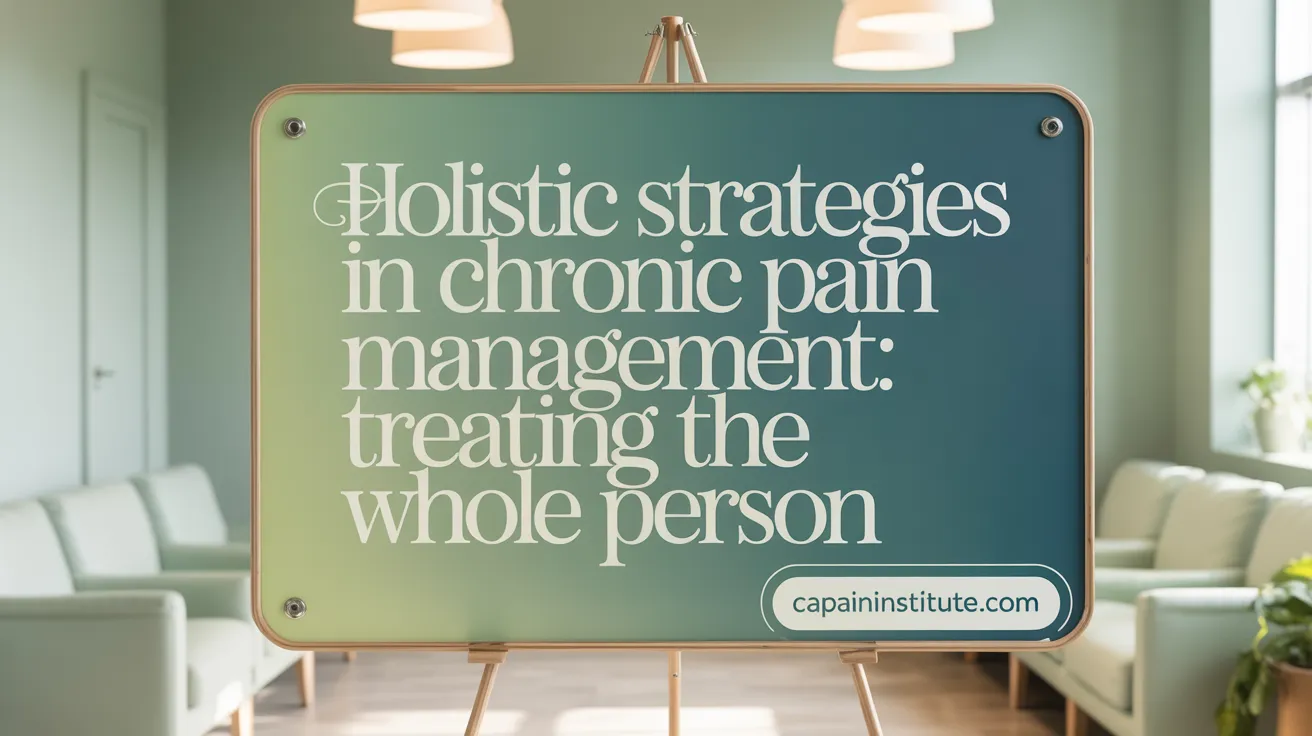Understanding the Challenge of Chronic Pain
Chronic pain affects millions of Americans, often persisting beyond the duration of an initial injury or illness and significantly impairing quality of life. With symptoms that can involve both physical discomfort and psychological distress, managing chronic pain poses a complex challenge that demands multifaceted strategies. This article explores holistic and integrative approaches centered on natural healing, mind-body techniques, and personalized care models as effective ways to manage long-term pain, while minimizing dependence on medications with undesirable side effects.
The Role of Holistic Approaches in Chronic Pain Management

What are the limitations of conventional medication in treating chronic pain?
Conventional medications, such as NSAIDs, opioids, and muscle relaxants, are commonly used as first-line treatments for chronic pain. However, these drugs often come with significant side effects including drowsiness, gastrointestinal issues, liver damage, and a high potential for dependence, especially with opioid use. Moreover, medication alone rarely addresses the multi-dimensional nature of chronic pain, which includes mental health challenges like depression, anxiety, and stress. This can limit their effectiveness and sometimes exacerbate the overall suffering of patients. For more on medication side effects and management strategies, see Pain medicine side effects.
Why are holistic strategies important in managing chronic pain?
Holistic approaches to chronic pain focus on treating the whole person rather than just the symptoms of pain. Since chronic pain affects physical, emotional, and psychological aspects, integrating techniques such as acupuncture for pain relief, exercise therapies like yoga and Tai Chi for pain management, mindfulness and meditation for stress reduction, and massage therapy can be highly beneficial. These methods reduce pain perception while also improving mental well-being and functional ability, without the common side effects linked to medications.
Prevalence and impact of chronic pain
Chronic pain affects an estimated 50 million Americans, with about 20 million experiencing high-impact pain that interferes with daily activities. It often leads to increased risk of mental health conditions such as depression, anxiety, and PTSD, highlighting the need for comprehensive care. See more on chronic pain statistics in the US and mental health and chronic pain.
Benefits of holistic strategies
Holistic care offers several advantages over medication-only treatments. It can enhance quality of life by promoting natural healing mechanisms, reducing medication dependency, and addressing underlying stress and emotional issues. Techniques like yoga, tai chi, and meditation not only ease pain but also foster mental resilience. Nutritional supplements with anti-inflammatory properties, such as turmeric and aloe vera, further support well-being.
In summary, holistic pain management emphasizes a safer, more comprehensive, and person-centered approach that targets both the physical and mental health consequences of chronic pain. For additional information, see Integrative chronic pain management approaches and Complementary health approaches to chronic pain.
Key Holistic Therapies for Long-Term Pain

What are some effective holistic therapies available for chronic pain?
Chronic pain affects millions and often requires comprehensive management beyond medications. Several holistic therapies offer effective relief and support natural healing.
Acupuncture involves inserting fine needles at strategic points on the body. This stimulates nerves and muscles, encouraging the release of endorphins which help reduce pain. Acupuncture has been shown to assist in conditions like back pain, migraines, and fibromyalgia.
Chiropractic care aims to realign the spine and neck, improving body function and alleviating pain. While commonly used for back pain, it can enhance mobility and reduce discomfort from musculoskeletal issues.
Massage therapy focuses on relaxing muscles, increasing blood flow, and lowering stress. Techniques such as Swedish massage and deep tissue can reduce muscle tension and pain, beneficial for conditions like neck and shoulder pain.
Mindfulness and meditation practices lower stress levels and muscle tension by calming the nervous system. These mind-body approaches help decrease the perception of pain and promote relaxation.
Exercise therapies like yoga and Tai Chi for pain management combine movement, stretching, breathing, and meditation. These improve flexibility, balance, and strengthen muscles, effectively managing arthritis, low-back pain, and headaches.
Vitamin and herbal supplements such as B vitamins, vitamin C and D, turmeric, and aloe vera support nerve health and reduce inflammation. Aloe vera's anti-inflammatory and analgesic compounds can relieve muscle and tendon pain when used topically or orally.
Together, these holistic therapies provide a multi-faceted approach to chronic pain management, often reducing reliance on medications and enhancing quality of life.
Integrative Care Models and Personalized Pain Management

How does integrative care enhance chronic pain management?
Integrative care enhances chronic pain management by combining multiple evidence-based therapies tailored specifically to each patient's needs. This approach targets different pain mechanisms simultaneously, which can lead to additive or synergistic effects—offering better pain relief and improved physical function. For more details, see What Do We Mean by Integrative Pain Care?
Combining therapies for additive effects
Management strategies often pair treatments such as physical therapy, acupuncture, mindfulness meditation, and medication to achieve greater overall impact. Using diverse therapies together can reduce reliance on any single approach, minimizing side effects and increasing efficacy. Learn more about complementary health approaches.
Patient-centered treatment planning
Personalized plans are developed by a multidisciplinary team including physicians, physical therapists, psychologists, and complementary care providers. These plans consider the patient's unique pain profile, lifestyle, and preferences to promote optimal outcomes. More about personalized chronic pain treatment plans.
Collaboration among healthcare providers
Effective integrative care depends on clear communication among clinicians and patients. Collaboration ensures treatments are safe, avoid negative interactions, and complement each other well. See Integrative Health Pain Guide for more on collaboration.
Addressing mental health and social support
Since chronic pain often worsens with psychological distress, integrative care includes interventions like cognitive behavioral therapy and social support to address emotional challenges and enhance coping skills. This holistic focus improves quality of life beyond just physical symptoms. Additional info on mental health and chronic pain.
Lifestyle Modifications and Self-Management Techniques

Gentle Exercise and Physical Activity
Engaging in gentle physical activities for pain relief like walking, swimming, gardening, exercise therapies like yoga and Tai Chi for pain management can significantly help ease chronic pain. These activities improve muscle flexibility, enhance circulation, and block pain signals, making them effective non-drug options for managing long-term pain. Gradually increasing activity levels based on individual tolerance ensures safety and maximizes benefits.
Stress Reduction Strategies
Stress can amplify pain perception. Techniques such as deep breathing, mindfulness meditation, and other relaxation exercises help lower stress levels and muscle tension. These practices promote a calmer nervous system response, which may decrease pain intensity and improve coping ability.
Sleep Hygiene
Maintaining a consistent sleep routine is crucial for managing chronic pain. Good sleep quality helps reduce pain sensitivity, while poor sleep can worsen symptoms. Avoiding naps, creating a restful environment, and establishing regular bedtimes support restorative sleep as highlighted in pain management educational materials.
Engaging in Hobbies and Social Connections
Participating in hobbies like photography, sewing, or knitting serves as a healthy distraction from pain. Social interactions through family visits, phone calls, or support groups provide emotional support, improving mental well-being and pain outcomes, as suggested by psychological therapies for chronic pain.
Education and Self-Management Courses
Accessing educational materials, such as the Pain Toolkit, and participating in self-management programs empower patients to understand their condition and adopt effective coping strategies. Such courses help reduce dependency on pain medications by teaching pacing, relaxation techniques, and positive mindset approaches.
These lifestyle and self-management approaches, taken together, offer a comprehensive, non-pharmacologic way to improve quality of life for individuals living with chronic pain.
Safety, Access, and Future Directions in Holistic Pain Care

What safety considerations should patients keep in mind when pursuing holistic pain treatments?
Patients engaging in holistic pain management should always consult their healthcare providers before starting new therapies. This step ensures compatibility with their current medical conditions and medications. For instance, herbal supplements like St John’s Wort or turmeric can interact with prescribed drugs, potentially causing adverse effects. Similarly, some physical treatments such as acupuncture and chiropractic care demand qualified practitioners to prevent injury. Open communication between patients and providers helps reduce risks and ensures a safer, personalized approach.
What challenges and opportunities exist in the adoption of holistic pain management?
Adoption of holistic pain care faces challenges like limited insurance coverage, which may restrict patient access to therapies such as acupuncture or massage therapy benefits. Moreover, scientific evidence varies among complementary treatments, causing hesitance among some healthcare professionals. Despite these obstacles, trends show growing research backing and education in integrative medicine. Medical schools increasingly train providers in nonpharmacologic options, and organizations like the NIH support studies exploring holistic methods. Such advancements promote wider acceptance and integration of holistic therapies alongside conventional pain management.
This evolving landscape promises improved accessibility and collaboration, enabling more people to benefit from safe, effective holistic strategies to chronic pain in managing chronic pain.
Towards a Comprehensive and Compassionate Approach to Chronic Pain
Managing long-term pain requires a shift from solely medication-based treatments toward holistic, patient-centered strategies that incorporate physical, psychological, and social dimensions of wellness. Integrating therapies such as acupuncture, mindfulness, physical activity, and nutritional support within personalized care plans can enhance pain relief, improve function, and reduce dependence on medications with harmful side effects. Collaborative healthcare approaches and patient education empower individuals to regain control over their condition, fostering resilience and better quality of life. As research continues to validate and refine these methods, holistic strategies stand as promising pillars in the evolving landscape of chronic pain management.
